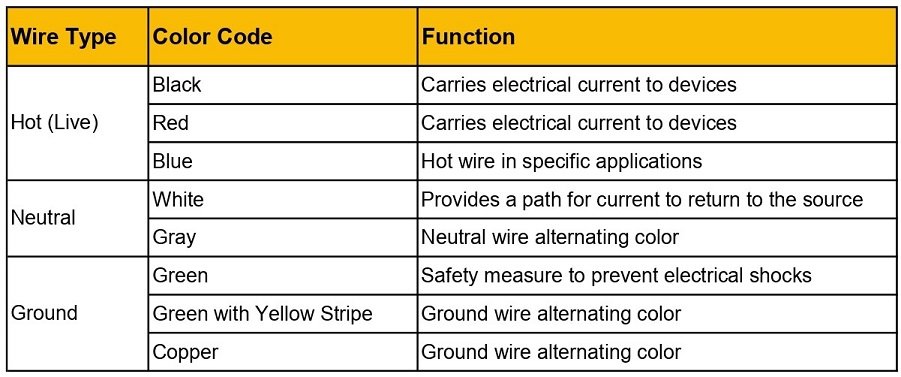Demystifying the Wire Color Code: A Must-Know
Why Is Wire Color Code Important?
The color coding of wires serves as an indication of the function and purpose of each wire. This visual identification system is essential for several reasons:
Safety
Electrical systems carry high voltages that can be dangerous if not handled properly. By following this code, electricians can easily identify the type of wire they are working with. Also, they can take the necessary precautions.
For example, electricians typically use a red wire for hot wires, and a white wire for neutral wires. Mixing up these wires could result in an electrical shock or fire hazard.
Efficiency
Color code ensures consistency across different electrical installations, making it easier for professionals to work on diverse projects. By having a standardized color code, electricians can quickly identify the correct wires and complete their work more efficiently. Lack of color coding makes it challenging to determine the proper placement of each wire. That cause the installation process longer and more complicated.
Standardization
Implementing standardized wire color codes guarantees constancy in various electrical systems and geographic locations, fostering a universal understanding and encouraging safer electrical practices. In a way, it facilitates clear communication on wiring diagrams, blueprints, and technical documentation.
Types of Wire
Residential and commercial electrical systems commonly encounter three primary types of wires, which are:
Live wire (hot wire)
This type of wire plays a crucial role in electrical systems. Hot wire responsible for carrying electric current from the power source to the connected devices. Without live wires, electricity would not be able to flow and power our appliances, lights, and other electrical equipment.
Identifying live wire from other wires in an electrical system is easy because of their distinct color. Typically, the color of live wires are black, red, or another color that is different from the neutral and ground wires. This color coding helps electricians and individuals working with electrical systems to identify and handle live wires safely.
In 3-phase line wiring, the color of live wire is normally blue for home or businesses. The blue color coding helps to detect these specific wires from other live wires in the system.
Ground wire
A ground wire is important in electrical systems as it safely allows electric current to flow into the ground. We do this to prevent electrical shock and ensure the safety of individuals and equipment.
The ground wire keeps an electrical system safe if something goes wrong, such as a short circuit or a voltage spike. It directs extra electrical current into the ground, avoiding any risk of it flowing through a person or machinery.
The color coding for ground wires is typically green or green with a yellow stripe. Using a unique color makes it simpler to verify the accurate connection and proper application of the ground wire.
Neutral wire
A neutral wire is a conductor that carries the current back to the power source, completing an electrical circuit. The color coding for neutral wires is usually white or gray.
The neutral wire is an important part of an electrical circuit because it completes the circuit and allows the current to flow back to the power source. Without the neutral wire, the circuit would not be complete and the electrical devices would not work.
Understanding Wire Color Code
The aim of standard wire color coding scheme is to provide clear and consistent identification of different wire types. The following table summarizes the common color designations for each type of wire in the US:
In electrical systems worldwide, different countries may adopt distinct wire color codes, each carrying its unique significance. Awareness of these international color codes is crucial for accurate installation and effective troubleshooting.
Conclusion
Wire color codes play a vital role in ensuring the operation safety of electrical systems. Understanding the importance of wire color coding enables us to make informed choices when dealing with electrical parts. This, in turn, helps reduce the potential for electrical dangers. Always remember to follow proper wire identification practices and consult a qualified electrician for complex electrical projects.


